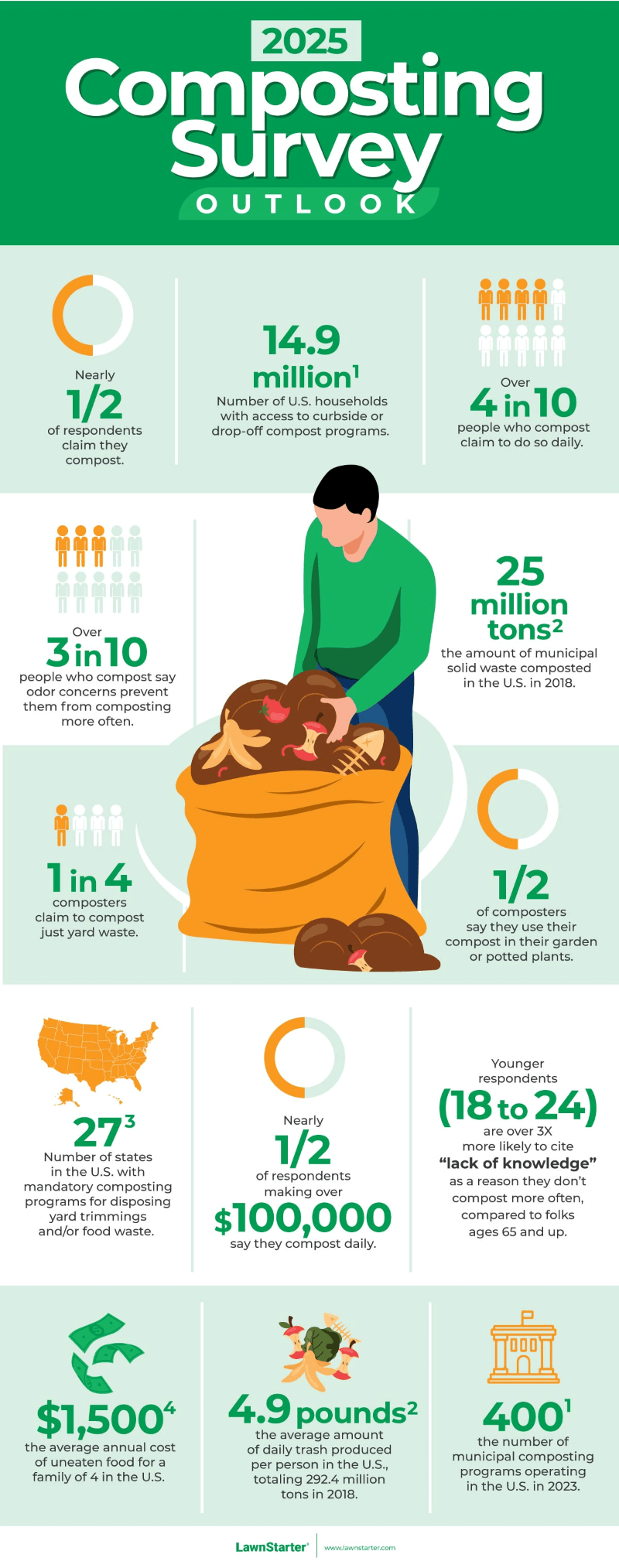
Composting isn’t small potatoes anymore. Nearly half of U.S. residents say they let Mother Nature recycle kitchen and yard waste for use in their own or their friends’ gardens.
With a new year for setting resolutions around the corner and numerous cities (and California) looking to hit a zero-waste target in 2025, LawnStarter surveyed over 2,100 U.S. residents on their composting habits and opinions and ranked 2025’s Best Cities for Composting.
For the city rankings, we compared the 500 biggest U.S. cities based on 5 categories. More specifically, we factored in access to municipal and private composting programs, zero-waste initiatives, yard size, and local interest in composting, among 11 total metrics.
Dig in to our survey results and ranking below. To learn how we ranked the cities, see our methodology.
Why does LawnStarter care about composting? Half of U.S. states require grass clippings and yard waste to be composted or collected separately from their other trash.
Cities like New York are currently rolling out mandatory composting programs. Curious about composting practices in the Big Apple? Read through our NYC composting survey.
Contents
- 2025 U.S. Composting Survey Outlook
- U.S. Composting Survey Results
- Survey Key Insights
- Behind the Survey
- City Rankings
- Top 5 Close Up
- City Rankings Key Insights
- Ask the Experts
- City Rankings Methodology
- Final Thoughts: Trash into Treasure
2025 U.S. Composting Survey Outlook

U.S. Composting Survey Results
Survey Key Insights
- A BioCycle survey from 2023 demonstrates that residential access to food waste collection has increased by 49% between 2021 and 2023, bringing curbside or drop-off compost programs to 14.9 million households.
Age
- Younger folks (18 to 24) are over 4X more likely to compost at a community garden or compost site than people who are 65 and older.
- With Age Comes Wisdom (and Time): Younger respondents (18 to 24) are over 3X more likely to cite “lack of knowledge” as a reason they don’t compost more often, compared to those ages 65 and up. The younger generation is also 2X more likely to say time constraints are keeping them from composting more.
- At 63.38%, respondents over 65 are most inclined to use compost in their garden and for potted plants.
Race + Ethnicity
- Black (41.50%) respondents are most likely to say they compost every day. At 21.43%, multiracial respondents are more likely to compost monthly.
Income
- Nearly 1/2 of respondents making over $100,000 say they compost on a daily basis.
- Odor concerns are keeping more than 1/2 of high-income respondents (making over $150,000) from composting more often.
- Those making over 6 figures are most likely to live in an area where their HOA prohibits composting — 12.39% for those making $100,000 to $149,999 and 10.45% for households with incomes above $150,000.
Education
- Respondents without a diploma or GED are almost 3X more likely to compost through a work program than those with a doctorate, advanced, or professional degree.
- Degrees Don’t Always Know Best: Those with advanced degrees are almost 2X more likely than those with no schooling to claim a lack of knowledge as an excuse for not composting. Those with advanced degrees are also 2.5X more likely to worry about odor and HOA restrictions than those with no schooling.
Gender
- Almost 55% more men than women claim their HOA prohibits composting.
- Almost 40% more men than women claim they dispose of their compost instead of repurposing it.
Behind the Survey
LawnStarter collected survey responses from a random sample of 2,165 U.S. residents aged 18 or older via Alchemer and Cint on October 22, 2024.
The first question includes responses from all 2,165, while the remaining 5 questions reflect data from 1,008 respondents who answered “yes” on the first question.
Each response was anonymized using a unique user ID generated and assigned by Cint.
Notes:
- This survey data does not stem from a probability sample, therefore no margin of error can be calculated.
- If comparing national data with our NYC survey results, note that some questions from the NYC survey allowed respondents to select multiple options (“select all that apply”), while within the U.S. survey respondents had to choose one option for the same questions.
City Rankings
See how each city fared in our ranking:
Top 5 Close Up
Check out the slideshow below for highlights on each of our top 5 cities for composting.
City Rankings Key Insights
81 cities in our ranking have access to curbside and/or drop-off composting programs implemented by their city. 143 cities in our ranking are home to at least 1 private composting hub and 168 cities are making strides with zero-waste initiatives.
All 117 California cities dominate in the top half of our ranking. Thanks to SB 1383, it is mandatory for local governments in the Golden State to provide organic waste recycling or composting services to all residents and businesses. Cali has a goal of diverting 75% of organic waste statewide by 2025.
Other states leading the way policy-wise are Massachusetts and Connecticut, requiring residents to separate yard trimmings and food waste from their trash. All 8 Connecticut and 13 Massachusetts cities finished in the top half of our ranking. Research shows that mandatory composting has had the most success in Massachusetts.
Many major U.S. cities with city-run composting programs tend not to have much yard space. Residents of cities like Cedar Rapids, Iowa (No. 78), Athens, Georgia (No. 85), and Missoula, Montana (No. 209), enjoy the best of both worlds, with access to municipal and private composting services in addition to ample lawn space for establishing their own compost pile.
Sort through more composting insights below.
Ask the Experts
Composting food scraps and grass clippings in your yard, community garden, or even in your kitchen can make a big dent in our landfills — accounting for over a third of our national waste.
14.9 million American households now have access to organic waste collection services, but ignorance and contamination from non-compostable materials like bioplastics are big obstacles to creating successful circular cities.
We turned to a panel of experts to help us lower the barriers to composting and share tips for limiting food waste. Explore their tips below.
- What are 3 misconceptions about composting?
- How would landfills be impacted if everyone in America composted?
- What are three advantages and 3 disadvantages of composting at home?
- How can apartment and condo dwellers best make use of their compost?
- What obstacles are preventing people from composting?
- How effective are policies like mandatory composting?
- How does food waste impact the environment?
- Apart from composting, what is 1 other way to reuse food scraps?






What are three misconceptions about composting?
- One of the biggest myths about composting is that it’s messy and requires a lot of maintenance. But it is manageable if we have the suitable materials.
- Another misconception is that it smells bad, but if we maintain proper aeration and balance the green and brown components, odors should be minimal.
- Lastly, while some people believe that composting only works with yard wastes, kitchen leftovers such as fruit peels and coffee grounds are also suitable for composting, making it a versatile and helpful technique.
How would landfills be impacted if everyone in America composted?
If everyone in America started composting, there would be a considerable drop in organic waste going to landfills, which now accounts for a significant portion of trash.
It would also help reduce the amount of waste that needs to be disposed of.
Another significant benefit would be reducing methane emissions—a potent greenhouse gas created by decomposing organic matter in landfills.
Furthermore, landfill space would last longer, increasing their usable life and lowering the need for additional disposal sites.
Overall, extensive composting could result in more sustainable waste management and a lower environmental footprint.
What are three advantages and three disadvantages of composting at home?
The benefits of home composting include:
- Reducing the waste sent to landfills.
- Making nutrient-rich soil for gardens.
- Saving money on fertilizers.
However, it has some disadvantages, such as:
- Pests if not well maintained.
- The need for space, which may be limited for apartment dwellers.
- The time it takes to maintain the composting system, especially for beginners.
Balancing these aspects is critical to making home composting a worthwhile experience.
How can apartment and condo dwellers best make use of their compost?
Apartment and condo dwellers can use their compost by starting small with a compact indoor composting bin or worm composting system, which is designed for limited space.
They can also partner with community gardens or local composting programs, where their compost can be collected and used.
Composting into container gardens or houseplants can boost nutrients and improve plant health.
Even without a garden, compost can benefit friends or neighbors who garden, promoting community sustainability.
What obstacles are preventing people from composting?
Several obstacles hinder people from composting.
1. One is the lack of space, particularly in metropolitan environments where individuals live in condos or apartments.
2. Limited knowledge about composting and its maintenance, concern about unpleasant odor, and fear of attracting pests are also there.
3. Sometimes there is limited access to these programs, which makes it more challenging for people.
How effective are policies like mandatory composting?
Mandatory composting policies can effectively reduce waste and encourage sustainable practices. These policies typically increase participation in composting programs and a notable decrease in organic waste sent to landfills. They can also drive broader environmental awareness and behavior change.
However, the success of such policies often depends on the availability of resources, community education, and proper implementation to address potential issues like enforcement and accessibility.
How does food waste impact the environment?
Food waste significantly affects the environment, mainly through the methane emissions generated during organic waste breakdown in landfills.
An increased environmental footprint results from the wastage of labor, water, and energy in the production, transportation, and disposal of wasted food.
Food waste reduction lessens the environmental impact and contributes to conserving these resources.
Apart from composting, what is one other way to reuse food scraps?
Making vegetable broth is an excellent approach to recycling food waste. It reduces waste and provides a great base for soups, stews, and sauces. It’s simple, yet impactful.

What are three misconceptions about composting?
1. Composting is smelly.
Composting is an aerobic process and when properly managed composting doesn’t produce strong odors.
2. It’s complicated.
Composting is actually very simple, and there are methods for all experience levels.
3. Everything that is biodegradable can be composted.
Not true, there is greenwashing out there. Biodegradable and compostable are not the same terms. Not all biodegradable items are compostable or suitable for home composting. Some need industrial facilities and should be certified compostable via the Biodegradable Products Institute (BPI) and field tested by the Compost Manufacturers Alliance (CMA).
How would landfills be impacted if everyone in America composted?
Composting would significantly reduce landfill waste and methane emissions, as nearly 30% of landfill content is organic waste. The EPA rates U.S. open-air landfills as number three on the list of sources of methane production.
Composting is an aerobic process and does not produce the GHG methane. This would cut greenhouse gas emissions and help combat climate change while creating nutrient-rich soil amendments. It would also preserve valuable landfill space that could be used for non-recyclable waste.
What are three advantages and three disadvantages of composting at home?
Advantages:
1. Waste reduction: Reduces household waste and carbon footprint.
2. Soil enrichment: Produces nutrient-rich compost for gardening.
3. You know what is in your compost. Make a good recipe with 30 parts Carbon (browns) and 1 part Nitrogen (greens), 45-50% moisture, and lots of bulking materials like wood chips for air space porosity, and you will have a create great starting batch of compost.
Disadvantages:
1. Space requirements: Requires outdoor space, challenging for urban dwellers.
2. Time and effort: Needs regular attention and maintenance.
3. Pests and odors: Poor management can attract pests and cause odors.
How can apartment and condo dwellers best make use of their compost?
They can use them on potted plants, in window boxes, or spread finished compost near their house to increase the organic material in any lawn or garden or donate to a nearby community garden.
What obstacles are preventing people from composting?
- Lack of awareness. We in America have such a single-use mindset. It can take just a little more effort to do something good like compost, but so many people don’t know or care to try.
- Also, space limitations: Limited outdoor space hinders composting efforts.
How effective are policies like mandatory composting?
The effectiveness of policies like mandatory composting is becoming more prevalent. Success depends on public education, proper infrastructure, and ease of participation.
How does food waste impact the environment?
The short answer is that food waste in landfills produces methane, a potent greenhouse gas. If we can think about “food waste” as “food scraps” we start to reframe how we view food that is not eaten. It’s basically an untapped resource.
Apart from composting, what is one other way to reuse food scraps?
If you cannot compost:
- Reduce the food you buy (source reduction).
- Donate that food to hungry people.
- Feed it to animals.
Then, we believe composting is the best last line of defense for these food scraps.

What are three misconceptions about composting?
While there are many misconceptions about composting, particularly industrial composting, three common ones include:
1. Consumers often believe that collecting organic waste is too complicated or time-consuming.
2. Municipalities may be hesitant to implement composting programs due to concerns about increased costs and the complexity of managing such systems.
3. There is a general lack of awareness about the significant carbon footprint reduction that composting can achieve for a community. Although understanding is improving, it may take years before cities and communities fully recognize and evaluate the environmental benefits of composting.
How would landfills be impacted if everyone in America composted?
Large amounts of organics could be composted in industrial or home composting and diverted from landfill. So, the large amount of methane generated by landfills, mostly in the U.S. collected through EPA’s Landfill Methane Outreach Program, will be reduced — but also most of the methane leakage from landfills will be avoided.
Organic collection and composting should be able to create a circular economy for the organic waste component of the Municipal Solid Waste.
What are three advantages and three disadvantages of composting at home?
A few things that come to my mind:
Advantages:
- Reduces the amount of waste sent to the collection system, which means fewer trucks on the road and less organic waste ending up in landfills.
- Produces nutrient-rich compost for gardening, offering economic benefits by reducing the need for store-bought fertilizers.
- Fosters a deeper connection with the environment, encouraging mindfulness and a greater awareness of sustainable practices.
Disadvantages:
- Requires setting up and maintaining a composting system at home, which can be challenging for those with limited space or resources.
- Demands regular attention and coordination to manage the composting process effectively.
- If not managed properly, home composting can become a nuisance, leading to unpleasant odors.
How can apartment and condo dwellers best make use of their compost?
One effective way is to participate in a city-wide compost collection program that offers incentives or rewards for participation.
Additionally, even with limited space, apartment and condo dwellers can use their compost to maintain small container gardens, growing herbs and vegetables without the use of chemicals, thus creating a sustainable and self-sufficient source of fresh produce.
What obstacles are preventing people from composting?
Knowledge, convenience, and incentives.
How effective are policies like mandatory composting?
They are necessary to make sure that we reduce organic waste and avoid sending organic waste to the landfill. Food and yard trimming waste represent more than 1/3 of the MSW in the U.S.
How does food waste impact the environment?
Food waste has a significant environmental impact.
Firstly, a vast amount of resources—such as water, energy, and labor—are used to produce food that ultimately goes to waste. When this food ends up in landfills, it undergoes anaerobic decomposition, leading to the production of methane, a potent greenhouse gas that contributes to climate change.
To mitigate this impact, we can improve our waste management systems by increasing organic waste collection in the U.S. and encouraging home composting where feasible, turning food waste into a resource rather than a liability

What are three misconceptions about composting?
1. That all paper and fiber products can be composted.
2. That materials are separated at the compost facilities when they arrive (they are not like they are at Material Recovery Centers that feed the recycling stream). All the material that comes into the system is processed (unless it is caught and removed when offloaded).
3. That we should compost everything that is certified compostable (like non-food items).
How would landfills be impacted if everyone in America composted?
Organics make up the largest portion of what is thrown in the landfill (representing 30-40% of landfill volumes), so this would significantly affect their volumes.
That also means that methane gas generated and not captured will be significantly reduced, which is a big win in fighting greenhouse gas emissions that lead to climate change.
What are three advantages and three disadvantages of composting at home?
Advantages:
- Material stays where it is made, and no emissions are generated by shipping it off-site.
- Compost can be used in so many applications, so when you make your own on a regular basis, you have a regular supply that you don’t have to pay for.
- You are not paying to landfill the yard and food scraps.
Disadvantages:
- It takes time, and some people start and then find out they don’t make the time to manage their piles optimally.
- You can’t home compost meat products or compostable packaging (in most cases) because they require high heat to process which is only possible at larger, commercial facilities.
- There may not be enough materials to compost to cover all areas of your home or business where compost is applied.
How can apartment and condo dwellers best make use of their compost?
- Compost can be mixed with other materials to make potting soil for container gardens on your deck
- Compost can be used around the property to feed the trees and other landscape areas, feeding natural nutrients and biology to plants.
- Compost is great for topdressing containers and indoor plants.
What obstacles are preventing people from composting?
- Lack of knowledge on how to do it right and what can be composted.
- For curbside collection, many cities lack the infrastructure for collection or processing, so many residents and businesses do not have access.
How effective are policies like mandatory composting?
Very effective. When we mandate or ban organics from landfilling, it creates a necessary rallying point for the scale needed to get more access, facilities, and collection program investment, as many funding options come with speculative tonnage projections that show there is a long-term business opportunity.
How does food waste impact the environment?
When it goes to landfills, it creates methane gas, which is a greenhouse gas that is as much as 22 times more impactful and a major contributor to climate change.
It is also prevented from being turned into beneficial compost, which serves so many purposes. It sequesters carbon in the soil (which is a great climate change mitigation strategy), when applied, it helps conserve water, and it minimizes chemical usage in the environment.
Apart from composting, what is one other way to reuse food scraps?
There is an EPA hierarchy that encourages the recovery of edible food scraps to feed people, and then the next level is to use food scraps to feed animals.

What are three misconceptions about composting?
1. Composting is complicated. Although composters need to follow a few simple guidelines, they don’t need to make it hard. For example, you don’t need to buy an expensive compost system — a pile in a corner of your backyard, preferably contained by a simple wooden/wire mesh bin, should suffice.
2. You do want to mix yard wastes and kitchen wastes (so-called “greens” and “browns”), but you don’t need exact ratios. You don’t need to buy bio activators or inoculum, fertilizers, or lime. Naturally occurring bacteria, fungi, and invertebrates like worms, slugs, and soldier fly larvae should be able to break down the organic material just fine.
3. Composting equals reducing food waste. My students commonly use the word composting for any strategy to reduce food waste. Actually, according to the US EPA, composting ranks fourth of six most preferred strategies for getting rid of food waste.
The best way to prevent food waste is, not surprisingly, not to waste food! This means buying and serving only what people in your household can eat. It also means viewing food date labels with a grain of salt, and instead using the smell test.
In the US, food date labels are not regulated except for baby food, which means that those “expires by,” or “best use by” dates on food items are at the discretion of the food companies, and are often based on when the food might taste the best but not when it’s unsafe to eat.
The next best strategy is donating food, for example to a food bank or sharing with colleagues at work or neighbors, followed by feeding left-over food to animals. Then comes composting, and finally land application or throwing out the food.
Why is composting not at the top? Because if we can donate food or feed it to animals, then we avoid any emissions and costs associated with producing more food to replace what we throw out. Composting is important for food that is not edible.
You have to have a backyard compost system. Increasing numbers of cities and states, concerned about the climate emissions of sending organic wastes to landfills, have drop-off centers or even curbside pickup of organic wastes. You can check out the food waste reduction nonprofit REFED for a list of state and federal policies and Harvard University’s Keeping Food
Out of the Landfill for policy ideas for states and localities.
Sources:
- 5 Composting Misconceptions
- Ten Myths About Composting
- Wasted Food Scale
- Compost Bugs: The Good and the Bad
How would landfills be impacted if everyone in America composted?
Wow! That would be amazing if everyone in America were able to prevent wasting food in the first place, and composted whatever food wastes they cannot avoid.
Organic wastes from yard clippings and food decomposing in landfills are the third largest source of methane emissions in the US, and remember methane is 84 times stronger than CO2 as a greenhouse gas contributing to global warming in the near-term.
We would reduce climate emissions, avoid cutting down forests to grow food that is wasted, and save water, landfill space, and money spent on food that is never consumed. The compost everyone produced — or so called “black gold” — would also contribute to the health of garden and farm soils.
What are three advantages and three disadvantages of composting at home?
Composting at home can save money associated with waste collection fees (in some cities, residents pay by the bin for trash pickup). It means you don’t have to drive your waste to a county or private composting company pickup station. And you will have the positive feelings associated with doing something good for the environment and your garden. Composting can even be a fun family activity where you teach your children about science and the environment.
Composting at home can become a small annoyance — you have to put food waste in a separate container and carry it out to the compost pile. If you don’t cover your food waste with yard waste, skunks and other wildlife may be more likely to visit your yard. And you have to nag your housemates about remembering to separate food waste and take the waste up to the bin.
How can apartment and condo dwellers best make use of their compost?
Use the finished compost on your potted plants. If you want to learn more about growing plants in apartments, you can check out Summer Rayne Oakes’s videos like Houseplant 101.
What obstacles are preventing people from composting?
Misconceptions about smell, animal pests, and the cost and complexity of compost bins and composting are barriers to composting.
In institutional settings like university dining halls, having bins with clear signs about what goes in them, can help students to separate their wastes.
How effective are policies like mandatory composting?
More and more states are implementing food waste laws requiring businesses and households to keep wastes out of landfills through drop-off centers and pickup programs. As these laws have been rolled out over the past ten years, they have experienced challenges in terms of compliance and other issues.
For example, the City of Denver mandates curbside pickup of organic wastes and provides households with special food waste bins. It has taken a while for residents to get used to sorting food scraps from other waste, and city workers often find plastic containers and other non-food items in the organic waste bins.
In cities around the country, consumer education and making waste disposal easy by providing free bins and pickup are essential in helping consumers make the jump from throwing all waste in one bin to separating out recyclables and food waste from landfill waste.
In terms of business-scale composting, Massachusetts stands out for its successful program. It has been able to reduce organic wastes going to the landfill by using “carrots” — such as building an extensive network of food-waste-composting sites, which makes it easy and affordable for businesses to comply with the law.
On the stick side, Massachusetts law does not include exemptions for particular businesses, imposes a cost for not following the rules, and is rigorous in conducting compliance checks. In short, more than fellow states, Massachusetts achieved results because it coupled composting infrastructure and enforcement.
How does food waste impact the environment?
According to ReFED, the go-to site for food waste science and policy, food waste contributes 6% of US climate emissions and a quarter of what ends up in landfills. If we stopped food waste, we could avoid the 22% of all freshwater use and 16% of cropland that is used in producing food humans never consume.
Food waste is the third largest contributor to emissions of the strong greenhouse gas methane, after livestock and energy production, in the US.
Apart from composting, what is one other way to reuse food scraps?
The website Love Food Hate Waste has great tips for avoiding wasting food in the first place. Everything from not falling for those “buy one, get one free” grocery specials which end up making us purchase more food than we need, to examining food “best use by” dates to see if the food is actually still good, to creative ways to transform leftovers into new meals. Readers might also want to check out food waste apps like Olio and Too Good To Go.
If you want to influence food waste beyond your backyard, check out Refed’s Insights Engine, the Food Recovery Network, or the Climate Action Now app’s food waste and composting campaign.
City Rankings Methodology
First, we determined the factors (metrics) that are most relevant to rank the Best Cities for Composting. We then assigned a weight to each factor based on its importance and grouped those factors into 5 categories: Infrastructure & Accessibility, Waste Initiatives & Policies, Local Interest, Climate, and Residential Space. The categories, factors, and their weights are listed in the table below.
For each of the 500 biggest U.S. cities, we then gathered data on each factor from the sources listed below the table.
Finally, we calculated scores (out of 100 points) for each city to determine its rank in each factor, each category, and overall. A city’s Overall Score is the average of its scores across all factors and categories. The highest Overall Score ranked “Best” (No. 1) and the lowest “Worst” (No. 500).
Notes:
- It is challenging to capture all the nuances of a successful composting project. We were unable to factor in rates of successful waste diversion, compost contamination, incentives, costs, or community participation rates due to a lack of data.
- Some organic waste facilities use anaerobic digestion to create biofuel and electricity from organics instead of producing compost.
- Weights for “Access to Municipal Composting” were distributed as: 1 point for curbside pick-up services and 0.5 points for drop-off services.
- Weights for “Access to Private Composting” were distributed as: 1 point for curbside pick-up services and 0.5 points for drop-off services.
- Weights for “State Policies” were distributed as: 1 point for regulations requiring separate yard waste collection and 1 point for regulations requiring separate food waste collection.
- The “Worst” among individual factors may not be No. 500 due to ties.
Sources: American Community Gardening Association, Federal Housing Finance Agency, Google Keyword Planner, metroSTOR, National Oceanic and Atmospheric Administration, Sustainable Packaging Coalition, U.S. Composting Council, U.S. Environmental Protection Agency, Waste Dive, WtERT, Zero Waste International Alliance
Final Thoughts: Trash into Treasure
One person’s trash is another one’s treasure — so it’s no surprise that compost is nicknamed “black gold.”
Some U.S. cities are attempting to decrease trash production through zero-waste initiatives and mandatory composting programs.
NYC is unrolling its curbside composting program, with mandatory separation of yard waste, food scraps, and food-soiled paper as an attempt to combat the city’s rat problem. The trial period ends in Spring 2025 when residents who fail to comply will be subject to fines.
We also surveyed NYC residents to see if they’ve started composting and gather their thoughts on the practice.
Food waste is costly for us and our environment. Families spend an average of $1,500 on uneaten food per year. Studies show composting can redirect over 1/3 of your food waste and grass trimmings from landfills.
Composting and recycling can get confusing — every sanitary department and waste management company has its own guidelines for what’s accepted in their facilities. Always check with your local service on how to best dispose of your waste to avoid compost contamination.
Why Separate Organics? 5 Benefits of Avoiding the Dumpster
- Reduces emissions by 34–84%.
- Using compost benefits soil health.
- Compost and mulch help increase erosion control.
- Healthy soil improves water retention.
- Disposing of organic waste at anaerobic digestion facilities creates biofuel and electricity.
You can make a difference no matter where you live. Put a compost bin in your kitchen or garage and start your own compost pile to start producing organic fertilizer to keep your lawn, plants, and soil healthy and thriving.
No backyard? No problem. Community composting may be available in your area.
For more composting tips and information, explore our guides below.
- Composting 101: How to Start Composting
- How to Compost Grass Clippings
- 5 Best Compost Bins of 2024
- Mulching vs. Bagging Grass Clippings
- What is Organic Fertilizer?
- How to Make Your Own Fertilizer at Home
- A Guide to Organic Lawn Fertilizer
With the holiday season here, remember to compost your pumpkins, Christmas tree, and eligible food scraps instead of dumping them in the trash.
Call a local LawnStarter pro to help you set up a spot in your yard for your new compost pile.
Media Resources
Quotes from LawnStarter Editor-in-Chief, Jeff Herman:
- Nearly 2 in 10 (18.23%) respondents making less than $50,000 say they utilize a community garden or composting site.
- 4 in 10 respondents claim they compost daily overall, compared to less than 3 in 10 respondents ages 18 to 24. However, over 1 in 5 of the youngest generation surveyed (18 to 24) attest to composting weekly (55.94%).
- Low-income respondents (earning less than $20,000) are 3.5X more likely to compost at work than those earning over $150,000.
- At 31.34%, folks making over $150,000 are more likely to compost just yard waste.
- Respondents ages 45 to 54 have the biggest preference for using compost on their lawns or around trees (29.07%).
- Respondents ages 18 to 24 had a higher preference (34.27%) for composting yard waste than the other age groups.
- Younger respondents (18 to 24) are over 11X more likely to say they give their compost away compared to folks who are 65 and above.
- Folks ages 18 to 24 are 5X as likely to compost just paper products than people ages 65 and up.
- There’s no doubt that San Francisco (No. 3) is running a successful composting (and recycling) program. However, residents have access to only 1 municipal curbside program, which has been criticized by locals for overcharging residents and creating a monopoly. On top of that, average San Francisco homeowners have the smallest yards for starting their own compost pile at home.
- Minnesota cities — St. Paul (No. 19) and Minneapolis (No. 9) — have the highest local interest in composting out of the cities in our ranking, according to Google searches (population-adjusted). The Twin Cities enjoy curbside and drop-off municipal composting access. Gopher State residents are required to compost their yard trimmings, and Minneapolis has a goal to divert 80% of waste from landfills by 2030.
- Residents of some high-ranking cities with access to composting facilities show low interest in composting, at least according to Google search results, like Jersey City, New Jersey (No. 53), Anchorage, Alaska (No. 84), and San Antonio (No. 56). Meanwhile, several low-ranking cities demonstrate among the highest local interest in composting — such as Woodbury, Minnesota (No. 308), Richmond, Virginia (No. 316), and Westminster, Colorado (No. 478).
- Atlanta (No. 103) and suburb Johns Creek (No. 221) demonstrate high local interest in composting, but lack municipal composting services.
- Don’t Mess With Texas: Austin (No. 34) and San Antonio (No. 56) lead the Lone Star State in our ranking with access to city-run curbside composting services and local private composting businesses. Austin has a goal of reducing waste by 90% by 2040 and San Antonio is aiming to divert 60% of organics and recyclables from landfills by 2025.
- 3 Colorado cities — Denver (No. 72), Boulder (No. 114), and Longmount (No. 148) — land in the top half with municipal composting services. Colorado Springs (No. 457) and Aurora (No. 463) tie with 18 other U.S. cities for having access to privately managed compost hubs offering both pick-up and drop-off services. Composting at home can be more challenging in the Centennial State due to its dry and cold climate.
- Las Vegas (No. 459) falls behind due to a lack of legislation and low local interest, but some are introducing creative composting solutions to manage the city’s casino-driven food waste. One business in the city accepts food scraps to feed over 27,000 livestock. Caesars is implementing AI technology to track and manage kitchen food waste. The city is also launching free composting services.
- Pittsburgh (No. 82) outranks Philadelphia (No. 108) with better access to community gardens and significantly higher local interest in composting.
- Recent legislation is expanding composting services throughout Washington state, with mandatory composting on the horizon for some single-family residents. Municipal codes in Seattle (No. 33) ban residents from trashing compostable and recyclable materials.
- Washington (No. 21) currently offers free food scrap drop-off sites — with plans to divert 80% of waste by 2040. Residents demonstrate high interest in composting.
Main Photo Credit: wavebreak3 / Adobe Stock / License




